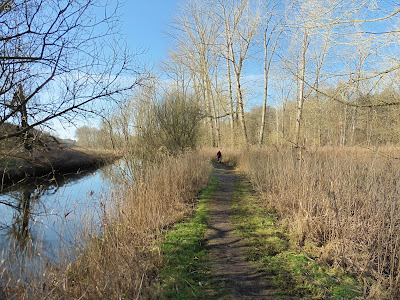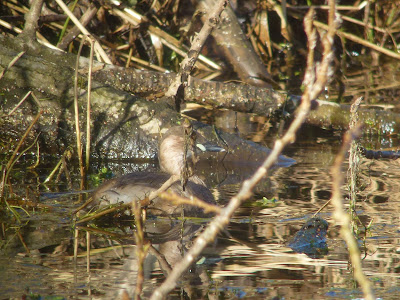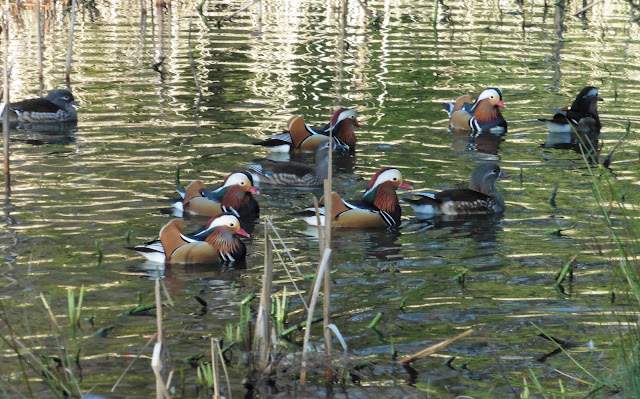Honeyguide’s first group in the Brecks followed last week’s recce visit and last night’s Storm Dudley. There were fallen branches in places, and twice very brief showers, but generally it was dry and bright, if a little windy sometimes.
We met at the Forestry Commission’s car park at Santon Downham – from which there were brief sightings of siskin and sparrowhawk – and we walked to and then by the river Little Ouse. It’s probably worth saying at the outset that were unsuccessful in finding lesser spotted woodpecker today; perhaps it was just a little too blustery. We started with a good view of a little grebe near some mallards on the river. Robins and great tits were singing and some in the group found a marsh tit.
 |
| Galls on reed. An oddly shaped gall on the left (JM), which Tim Strudwick advises is made by the 'corkscrew gall mite' Steneotarsonemus phragmitidis. On the right is a more typical cigar gall (CD). |
 |
| Violet ground beetle wing case. |
Being a group of Honeyguiders, we were finding other things of natural history interest, despite the winter season. Ann showed us cigar galls on reeds, created by a frit fly (no that's not a typing error). With our eye in for these, soon there were many more. Jillian found the wing cases of a violet ground beetle; some saw an otter spraint; we enjoyed the occasional clump of snowdrops. There were even a few fungi: these included what looked like a species of funnel and, viewed through the telescope, a hoof fungus on a birch stump.
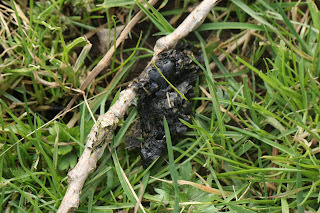 |
| Otter spraint (JM). |
 |
| Funnel (common funnel?) and distant digiscoped hoof fungus. |
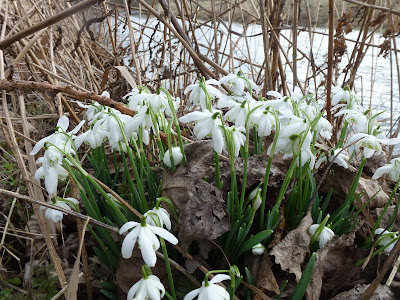 |
| Snowdrops on the river bank. |
We turned alongside a reedbed and marshes with Highland cattle, under a railway bridge and onto a heath. We looked at robin’s pincushions on dog rose and saw a sparrowhawk flying through. We paused to overlook Santon Warren. Here there were four mistle thrushes feeding on the ground, and Jillian was alert to a green woodpecker, also on the heath though moving all too quickly out of view. In the distance were some konik ponies, here for conservation grazing. A nuthatch was calling loudly over our heads near the level crossing on the short walk back to the car park.
We moved to Brandon County Park to eat our picnics, passing signs saying closed on Friday (the next day) on account of the impending Storm Eunice. Jon & Julia looked around the walled garden. Ann pointed out easy-to-overlook flowers on yew, and a cherry plum also had its first few blooms. Then we walked the short distance to the small lake where we easily found a small group of mandarins, four drakes and a duck today.
 |
| Yew tree flowers (AG). |
We visited Lynford Arboretum for the rest of the afternoon, chatting to various birdwatchers about what was around as we progressed. A group of siskins was high in a conifer, distant dots through binoculars though clear through a telescope. There was lots of bird activity where the Forestry Commission puts out food. Stars of the show here were bramblings: the best count was seven.
 |
| Hawfinch tree: we spent much time looking in and under this tree. Telescopes were essential! |
Would hawfinches show today? At first, it was mostly redwings in and under the hornbeams in the meadow. But soon Rob picked up on a single hawfinch on the ground, and it was consistently there with redwings and chaffinches, though we needed a little patience to see it when it hopped out of view or took flight into the branches for a time. Moving along the path a bit, the angle of the light was better and from here we enjoyed three hawfinches high in a tree, under a starling. As we returned, there was a hawfinch on the ground again with a greenfinch and more redwings. Two great spotted woodpeckers flew through, as did a buzzard.
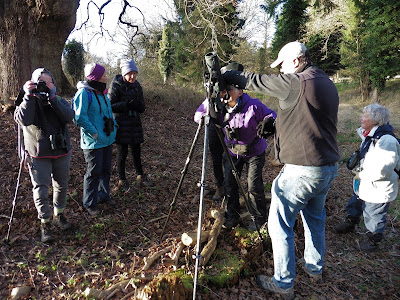 |
| Looking for a tawny owl. |
I still don’t know how he managed it, but Rob somehow found the roosting tawny owl high in a fir tree and rigged up his telescope to view it at a distinctly challenging angle. But, with a helping hand, everyone managed to see it, not necessarily looking elegant in the process. A goldcrest did some fly-catching.
Back where bird food was provided there were three yellowhammers with the finches and both coat tit and marsh tit picking seeds off the ground. A male muntjac walked into the clearing and watched us watching him. A song thrush was singing as we returned to our cars.
Guided walk with Rob Lucking and Chris Durdin. Blog by Chris.

